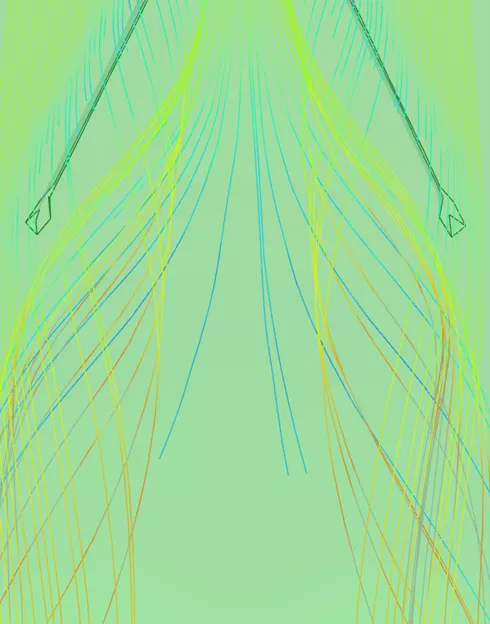Turbulence Models in 3DEXPERIENCE Fluid Dynamics Engineer Role
The Fluid Dynamics Engineer Role on the 3DEXPERIENCE Platform allows users to select between three turbulence models: Spalart-Allmaras, SST k-ω, and Realizable k-ε. In this article, we'll break them down to help you gain a better understanding of the differences between them and the strengths and limitations of each.
What Are Turbulence Models?
Turbulence models are mathematical models used in Computational Fluid Dynamics (CFD) to simulate turbulent flow. Turbulent flow is characterized by turbulent eddies or vortices generated by fluid motion. These eddies range in size from several times the size of the flow domain down to the molecular scale. The image below shows the development of turbulence vortices of a pair of vortex generators.

Turbulence models attempt to describe the behavior of these eddies and their interactions and provide a way to predict the effects of turbulence on the overall flow behavior. There are several types of turbulence models, but most are based on the concept of eddy viscosity, which measures the turbulent momentum transfer between adjacent fluid layers. In these models, the turbulent eddies are assumed to behave like an effective fluid with a much higher viscosity than the fluid's molecular viscosity.
Turbulence models are essential for simulating many practical engineering applications, such as aircraft design, automobiles, and industrial processes. However, it is important to note that turbulence models are simplified representations of a complex physical phenomenon, and many factors can affect the accuracy of their predictions. As a result, selecting and validating a turbulence model for a specific application requires some understanding of the underlying physics and careful consideration of the model's strengths and limitations, which this article will help with.
Comparisons
The Spalart-Allmaras model is a one-equation model that uses a single transport equation for the turbulent viscosity, making it computationally efficient for low-Reynolds number flows. However, it has limitations for high-Reynolds number flows, and its accuracy can be affected by complex flow features such as flow separation and pressure gradients. In the aerodynamics industry, this model is the industry standard.
The SST k-ω model is a two-equation model that combines the k-ω model near the wall and the k-ε model in the outer layer of the boundary layer, providing accurate predictions for both low and high-Reynolds number flows. This allows for superior prediction of skin friction and other boundary layer behavior. It also includes a blending function that switches between the two models in the transition region, making it more versatile than other models. The SST k-ω model can require careful calibration of the empirical coefficients; however, Dassault Systémes has calibrated the coefficients to work for general applications. If desired, a user can modify the coefficients to match their application. While it can be computationally expensive, this model is the “gold standard” in the automotive industry.
The Realizable k-ε model is another two-equation model that improves over the standard k-ε model. It includes modifications to the turbulence dissipation rate equation, making it more physically accurate and providing better predictions for flows with complex features such as swirling or rotating flows. The Realizable k-ε model, however, requires a higher level of expertise to set up, and its performance can be sensitive to the initial conditions and boundary conditions.
Below is a table summarizing the information above.
| Turbulence Model | # of Equations | Re Range |
Strengths | Limitations |
|---|---|---|---|---|
| Spalart-Allmaras | One | Low |
Computationally efficient, suitable for low-Reynolds number flows. Aerodynamics |
Limited accuracy for high-Reynolds number flows, sensitive to complex flow features |
| SST k-ω | Two | Low to High | Versatile, accurate predictions for various flow regimes, blending function for effective modeling of near-wall behavior. Automotive | Can be computationally expensive |
| Realizable k-ε | Two | Low to High | Improved accuracy for complex and anisotropic flows with swirling or rotating features. Best for internal flows | Sensitive to initial and boundary conditions |
Note: Dassault Systémes periodically recalibrates the default turbulence coefficients to ensure the results align with experimental and industry standards.
Summary
Each turbulence model has its own strengths and limitations, and selecting a suitable model depends on the specific application and the level of accuracy required. The Spalart-Allmaras model is a good choice for low-Reynolds number flows, while the SST k-ω model is more versatile and can handle a wider range of flow regimes. The Realizable k-ε model suits complex flows with swirling or rotating features. When using the Fluid Dynamics Engineer Role, one must carefully evaluate each model's performance and choose the most appropriate option for the given application. Subsequent parts of this story will dig into each model and provide examples of their strengths.
I hope you found this article explaining 3DEXPERIENCE Fluid Dynamics Engineer role turbulence models helpful. Check out more articles below.
More 3DEXPERIENCE Articles
3DEXPERIENCE Fluid Dynamics Engineer: Simple Internal Flow
3DEXPERIENCE Platform 2023x FD03 Release: Top Enhancements
Create 3DEXPERIENCE Simulation Study Search Widget
3DEXPERIENCE Platform Beam Analysis

About Andrew Smith
Andrew Smith is an Application Engineer and Simulation Specialist at GoEngineer. Andrew earned his bachelor’s degree in mechanical and aerospace engineering and his master’s degree in mechanical engineering at Utah State University, where he wrote his thesis on baseball aerodynamics and discovered the Seam-Shifted-Wake. He is passionate about engineering, fluid dynamics, and simulation and loves helping others find the best engineering solution for their problem. When not working, Andrew can be found reading crag-side or mountain biking with his family.
Get our wide array of technical resources delivered right to your inbox.
Unsubscribe at any time.